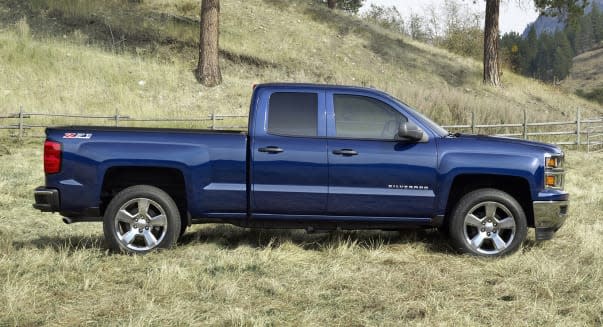Will Rising Profits Help GM Cruise Past Its Recall Fiasco?

General Motors (GM) reported a third-quarter profit that beat estimates Thursday, thanks in part to strong U.S. sales of pickup trucks and sport utility vehicles.
Excluding some one-time items, GM's profit rose to $0.97 a share. That's up a penny from a year ago, and $0.02 ahead of Wall Street's estimate.
Some Wall Street analysts had expressed concern that GM's earnings would be hit hard by challenges in Russia and South America. But the damage was less serious than they had feared -- and GM's new trucks helped offset much of it.
New Trucks and SUVs Have Improved GM's Profits at Home
GM introduced all-new versions of its Chevy Silverado and GMC Sierra pickups last year, and new versions of its big SUVs earlier in 2014. Those products have posted good sales gains -- but more important, they're commanding much stronger markups than their predecessors.
The old Silverado and Sierra sold well too -- but to get those strong sales, GM needed to offer high incentives. Incentives are the cash-back and cheap-financing deals that are so often featured in automakers' ads. Automakers use them as a way to adjust pricing in response to competition or market conditions. High incentives can boost sales quite a bit -- but at the expense of profits.
GM's exact profit per sale is a closely guarded secret. But it's no secret that its new pickups and SUVs are much more profitable than the old ones. That means, for instance, that even though the Silverado's sales gains have been modest -- up 5.9 percent this year through September, versus a 22 percent gain for Fiat Chrysler's Ram -- GM's profits on the Silverado (and its other trucks) are almost certainly up quite a bit more.
Earlier this year, those improved profits helped offset the steep costs of GM's massive recalls, keeping the company in the black. With recall-related costs mostly in the past, that money goes to GM's bottom line. The result: a $2.5 billion profit in North America, and an outstanding 9.5 percent operating profit margin.
Working to Turn Around Losses in Europe and South America
That profit margin is a big achievement for GM's new management, which has been focused on closing the profitability gap with rival Ford (F) in GM's home market.
But GM's overseas divisions aren't nearly as profitable as North America. CEO Mary Barra has said that GM's goal is to consistently post a 9.5 percent profit margin for the whole company by early next decade. And GM still has a lot of work to do to get there.
That work starts with Europe, where GM lost $387 million in the third quarter. GM has lost billions in Europe in recent years, but it's working on an aggressive turnaround plan that is expected to swing those losses to profits by 2016.
The company has made progress. New models like the popular Opel Mokka SUV, a near-twin to the U.S.-market Buick Encore, have helped sales and profits. Meanwhile, a new management team has reduced costs, boosted sales, and helped integrate the Opel brand more closely with GM's global product plans.
More recently, challenges in South America have weighed on GM and its key rivals. Those rivals include Ford, which warned last month that it would lose a billion dollars in South America in 2014 following big slowdowns in Brazil and some other Latin American nations.
GM South America isn't doing quite that badly. But it did lose $32 million in the third quarter, down from a solid $284 million profit a year ago.
GM Is Still Strong in China, and Working to Get Stronger
Asia has been a bright spot for GM for several years now. Barra noted on Thursday that GM has a 15.2 percent share of China's market, the world's largest. That's second only to mighty Volkswagen (VLKAY) -- and GM is investing aggressively to ensure that its growth outpaces that of the overall market.
It may sound ironic to Americans, but GM's Chinese unit was caught off guard by a boom in SUV sales that materialized over the past couple of years. Of course, GM sells plenty of SUVs and crossovers in the U.S. and other markets, but it didn't have many in China. That will change over the next year or two as GM sets up new manufacturing lines for several of those SUV models in China.
Meanwhile, its existing products are still doing well. GM's Asian joint ventures made $490 million in the third quarter. Most of that was from China, and it was good enough to give GM a 9.6 percent operating profit margin in the world's largest auto market.
How GM Will Put the Recalls in the Past
Barra is clearly hoping to put GM's recall mess in the rearview mirror and get investors -- and customers -- focused on its much-improved cars and trucks, and its improving profit picture.
That will take time. GM has recalled over 30 million vehicles this year, and many have yet to be fixed. There are still lawsuits pending, and GM may end up paying billions to settle potential criminal charges.
Barra and her team can't really control how all of that unfolds. But the things they can control -- GM's business efforts and its products -- are steadily improving, and the company's long-term plans are still on track.
Those improvements, in time, are how Barra and GM will make the recalls old news.
Motley Fool contributor John Rosevear owns shares of Ford and General Motors. The Motley Fool recommends Ford and General Motors and owns shares of Ford. Try any of our Foolish newsletter services free for 30 days. Find out the easy way for investors to ride the new mega-trend in the automotive industry in our free report.

